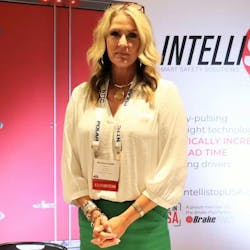Safety-focused fleet wins first federal Intellistop exemption
Gemini Motor Transport, the primary fuel hauler for Love’s Travel Stops, collected its third North American safety championship during the National Tank Truck Carriers’ 2024 Annual Conference in Las Vegas.
Three days later, it won the first exemption for Intellistop’s pulsating brake lamp module.
The long-awaited Federal Motor Carrier Safety Administration decision, secured with help from NTTC and Intellistop president Michelle Hanby, finally hit the Federal Register more than 15 months after it was published, 20 months after it was submitted, and nearly three and a half years after Intellistop filed the original exemption application for its safety device, which FMCSA only denied after Hanby petitioned a D.C. court to compel a ruling—all of which leaves Gemini’s Jim Dillon scratching his head.
“No one is more aggressive when it comes to safety than Gemini,” Dillon, Gemini truck assets manager, insisted. “We look at every aspect, and every single angle we can, to make our equipment safer, not only for our drivers but for the motoring public who’s out there with us. So it’s hard to believe it took this long and this much struggle to get something a lot of people feel is going to make trucks safer.
“I don’t have a good explanation for their rationale in dragging this out forever.”
See also: Court upholds FMCSA’s denial of Intellistop’s exemption request
The first Intellistop exemption took so long that Jack Van Steenburg, whose emails to Hanby in January 2022 provided the first indication FMCSA and the National Highway Traffic Safety Administration aren’t fully aligned, retired from his position as FMCSA executive director—the agency’s highest career office—and spent a year on the sideline before returning as a commercial vehicle safety consultant ready to share his frustration with a system that limits the speed of innovation.
“By the time we do more research and come up with a new rule in the Federal Motor Vehicle Safety Standards, it’s too late,” he told FleetOwner affiliate Bulk Transporter. “The technology we have today is still evolving, and the federal government gets caught up with rulemaking—and the process to change a rulemaking is not efficient at all.”
The research
Besides, NHTSA already conducted extensive research on this issue.
The administration first examined enhanced rear lighting and signaling systems in 2002. In 2009, it produced the “Evaluation of Enhanced Brake Lights Using Surrogate Safety Metrics” report, which acknowledged that “previous work had shown promise for reducing the number and severity of rear-end crashes” with flashing brake lamps. Its current work indicates that “flashing improves rated attention-getting.”
Additionally, Groendyke Transport showed in 2017 that tank trailers equipped with auxiliary brake-activated pulsating lights were involved in 33.7% fewer rear-end collisions than trailers with only “steady-burning” brake lamps over two years, compelling evidence of the lamps’ safety benefit that helped it score the first “parts and accessories” exemption from Part 393.25(e) of the Federal Motor Vehicle Safety Regulations allowing the installation of pulsating brake lamps on the rear of trailers in April 2019.
Every current and former law enforcement officer Bulk Transporter interviewed over the last two years is equally convinced.
Nick Wright, a technical trooper with the Kansas Highway Patrol’s commercial motor vehicle enforcement division—who also is the troop’s public resource officer and lead instructor—cited Groendyke when he first saw the lights. Then he talked to Groendyke’s Wichita terminal manager, who revealed their trucks enjoyed an 80% reduction in rear-end crashes the first year they were installed, leading Wright to tell officers to use “common sense” when writing flashing-light violations in the future.
“My take was, I don’t know of anything that has probably saved lives and reduced injuries and property damage so significantly—especially for something that was illegal when it first came out,” he said.
FMCSA granted three similar exemptions over the next three years but skipped Intellistop’s application, neither ruling for or against until Hanby filed a petition in the U.S. Court of Appeals for the District of Columbia on Sept. 7, 2022, long after the federally mandated window of 180 days for a decision expired. The U.S. Department of Transportation agency finally ruled against Intellistop on Oct. 7, 2022—659 days after Hanby applied, leading seven motor carriers, including Gemini, to submit their own Intellistop exemption applications, which FMCSA published in January and February 2023.
An appeals court later upheld FMCSA’s confounding decision in July 2023.
“How many accidents have happened that we could have prevented?” Hanby wondered. “How many people have died? And NHTSA’s already done the research—$2 million worth of research—with taxpayer money.”
The rivalry
So why did Intellistop’s request languish in bureaucratic limbo for two years?
See Bulk Transporter’s previous reporting here, here, and here for a deeper dive, but essentially, Intellistop’s application invoked the authorities of both FMCSA, which regulates the “in-use” operation of commercial vehicles, and NHTSA, which oversees the assembly of new vehicles, equipment, and technology; and while NHTSA grudgingly accepted FMCSA’s previous determinations, which allow fleets to install auxiliary brake-activated pulsating lamps, it was unwilling to agree to an exemption that allows “manufacturers” to make existing trailer lights “inoperative.”
The agency impasse also involved the definition of “steady burning,” the difference between pulsating and flashing lights—pulsating lights dim and brighten while flashing lights turn off and on—and the standard for granting an exemption. “We weren’t on the same page,” Van Steenburg confirmed. “Their view was the device is contradictory to the Federal Motor Vehicle Safety Standards, and maybe it is, but the statute allows us to grant an exemption that differs from the FMVSS [No. 108 in this case]—if you establish that an equal or better level of safety is likely to be achieved if the exemption is granted.
“I think NHTSA got it wrong on this one.”
So does Luke Loy, an engineer whose name is on FMCSA’s Intellistop denial and multiple exemptions the agency granted before he retired in June 2023 following a 33-year DOT career with FMCSA and NHTSA. He said last year FMCSA wanted to approve Intellistop’s application, but NHTSA blocked it, and he called the ruling he helped compose “arbitrary and capricious” because California’s long-standing vehicle code permits flashing stop lamps on any motor vehicle.
“Did NHTSA ever tell California this was an unsafe technology?” asked Loy, who served in FMCSA’s Vehicle and Roadside Inspection Division. “Because California doesn’t mandate it, but they sure as heck allow it. So how can you sit there as NHTSA and say ‘Well, we don’t know what the unintended consequences are.’
“Why don’t you ask California? It’s only the most populous state in the union.”
In 2022, Bulk Transporter asked Richard Van Iderstine, a retired NHTSA lighting standards engineer, about pulsating brake lights and Intellistop’s module. He didn’t oppose using flashing lights on trailers and even suggested it might be time to revise an ancient regulation given advances in lighting technology. However, he also said NHTSA historically is “adamantly against” flashing brake lights on vehicles without center-mounted stop lamps because someone might mistake one for a turn signal.
So, instead of waiting for NHTSA to evolve, Van Steenburg and Loy sought to grant Intellistop’s exemption. “I believe in change,” Van Steenburg said. “I believe in trying new things. I don’t believe in complacency. Complacency will kill you. It’s not a good thing. So you’ve always got to try to reinvent the wheel. I stood for that my whole career. I like trying different things, so I was very supportive of it.”
The reality
NHTSA and the few public commenters who’ve opposed pulsating brake lamp exemptions, frequently cite the potential for confusion or distraction for their position. Wright doesn’t buy it.
“To me, if there’s any confusion [with a turn signal], it’s going to be resolved in half a second, because they’re going to think, ‘What’s that? Oh, OK, they’re stopping,’ or ‘OK, it’s a right-turn signal,’” he said. He compared the “minimal” delay to the time drivers take to process unfamiliar signals in new locations and said the more pressing issue is passenger vehicles rear-ending tank trailers—a problem exacerbated by today’s cell phone-distracted drivers and a nearly 100-year-old, hazard-creating regulation that requires vehicles transporting hazardous materials to stop at all railroad tracks.
“My opinion is the regulations need to be changed to avoid some of these rear-end crashes,” he said. “But I hope these flashing lights on tankers will help reduce some of that and catch peoples’ eyes better.”
See also: Intellistop exemptions flood Federal Register
Wright also acknowledges the inconsistencies in enforcement, state legislation, and recommended best practices regarding flashing brake lamps; and agrees with Van Steenburg’s assertion that society can’t wait for more data when it comes to proliferating life-saving devices when distracted driving is statistically worse than drunk driving—and most people will never admit to texting while driving.
“Are there going to be a few people who run into the back of truck because they don’t know what the light means? Maybe,” he said. “But how many crashes are we avoiding? And you’re probably never going to know that number. It’s difficult to determine what you’re actually preventing.”
Proponents of Intellistop’s module, which pulsates the rear clearance, identification, and brake lamps four times in 2 seconds when the brakes are applied, argue the device is safer, cheaper, and easier to install than competing solutions. In Gemini’s case, 25 of the 26 commenters, including NTTC, American Trucking Associations, the National Truck Equipment Association, and the Transportation Safety Equipment Institute, favored the exemption, and FMCSA finally approved it—with unanticipated limitations.
“We were excited to finally receive the exemption because we truly believe in the product,” Dillon said. “We think it does make our trucks safer by notifying drivers that we’re slowing down or stopping, so it’s nice to now have an exemption where we can officially install them on some of our units.
“The downside is there are a bunch of reporting requirements we weren’t expecting.”
The rub
The five-year exemption limits Gemini to installing Intellistop’s module on 25% of its trailers the first year and 50% the second year while maintaining an equal-size control group and submitting quarterly and annual data updates.
“If NHTSA wants data—and they always want data, that’s what they hang their hat on—why wouldn’t they allow us to generate more data quicker?” Hanby lamented. “Twenty-five percent of a fleet is not a lot of trailers. It’s certainly not a business plan. Nobody is going to stay in business selling a safety product by only equipping 25 trailers here, 25 trailers there. But FMCSA had to appease NHTSA to get the exemption through. That’s why the stipulations are there.
“FMCSA knows Intellistop works. Unfortunately, they have to play the game.”
Even worse, they’re already late to this one, Van Steenburg added.
“If we had started the research three years ago, when Intellistop’s exemption first came in, we would be three years into it,” he said. “Now, Gemini has to start supplying data, and we’re already three years behind.”
See also: Court upholds FMCSA’s denial of Intellistop’s exemption request
Oddly, Gemini wasn’t the first fleet to file for an Intellistop exemption either. Encore Building Products’ application hit the Federal Register on Jan. 27, five days before FMCSA published Gemini’s. Now Hanby is left to wonder how much longer the other six fleets must wait for a ruling, if their exemptions will include similar stipulations, and how FMCSA will handle other parts and accessories exemptions granted to NTTC, Grote Industries, and Waste Management—and for other emerging technologies—when they’re up for renewal if operators already installed the devices on more than 25% of their vehicles.
“If this is the new guideline, I hope they at least keep it consistent,” she said.
She’s also hoping more fleets will now file for their own exemptions, although Van Steenburg, just like Loy, says that approach is onerous for carriers and could cause further complications for the agency. “If a thousand carriers wanted to use this technology, FMCSA most certainly would not have the means or capability to do its due diligence with all those requests.
“It’s certainly a lot easier to exempt the manufacturer.”
Of course, nothing in this saga has come easily—or expeditiously—and Hanby doesn’t expect that to change. But she’s optimistic this is a positive first step toward wider adoption of a preferred safety product. “Gemini is one of the safest fleets in the nation,” Hanby concluded. “They just won their third Heil trophy.
“They’re who FMCSA should look to for safety, and follow their lead.”
This article was originally published on Bulk Transporter.
About the Author

Jason McDaniel
Jason McDaniel, based in the Houston TX area, has nearly 20 years of experience as a journalist. He spent 15 writing and editing for daily newspapers, including the Houston Chronicle, and began covering the commercial vehicle industry in 2018. He was named editor of Bulk Transporter and Refrigerated Transporter magazines in July 2020.



